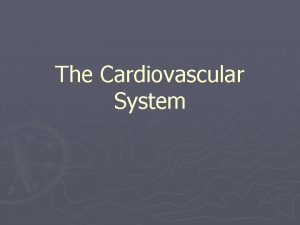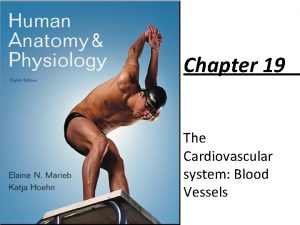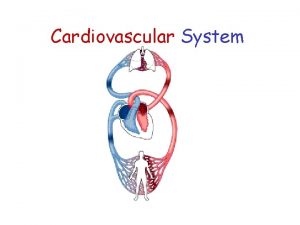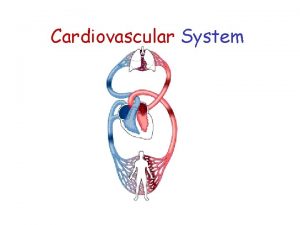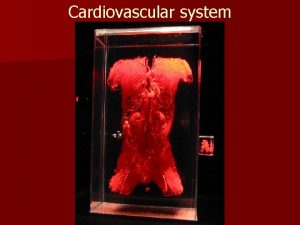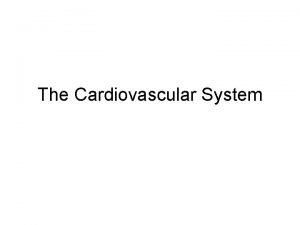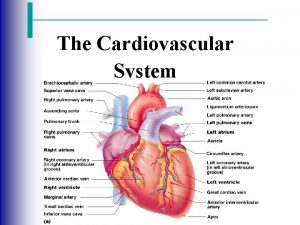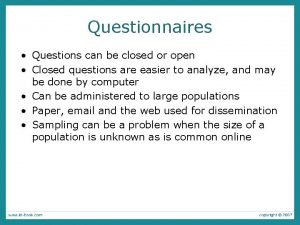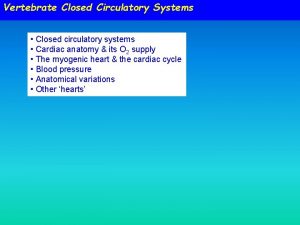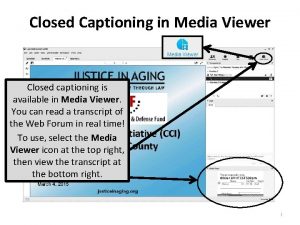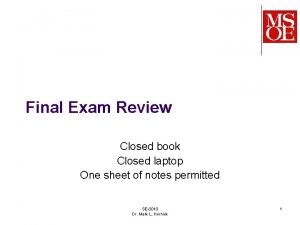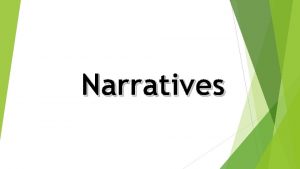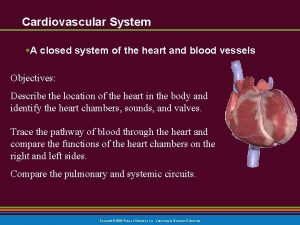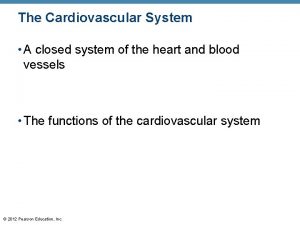Cardiovascular System The Cardiovascular System A closed system


























- Slides: 26

Cardiovascular System

The Cardiovascular System · A closed system of the heart and blood vessels · The function of the cardiovascular system is to deliver oxygen and nutrients and to remove carbon dioxide and other waste products

Myocardial Infarction: Open Topic • What is a heart attack? • What are the signs? • What should you do if you see someone experiencing symptoms?

Warning Signs of Heart Attack Videos Testimonials • Chest discomfort. Most heart attacks involve discomfort in the center of the chest that lasts for more than a few minutes, or goes away and comes back. The discomfort can feel like uncomfortable pressure, squeezing, fullness, or pain. • Discomfort in other areas of the upper body. Can include pain or discomfort in one or both arms, the back, neck, jaw, or stomach. • Shortness of breath. Often comes along with chest discomfort. But it also can occur before chest discomfort. • Other symptoms. May include breaking out in a cold sweat, nausea, or light-headedness.

What is a heart attack? • Watch and find out!

What is done after a heart attack? • • • Many things depending on the problem. Medication Open Heart Coronary Bypass surgery Corrective Surgery Angioplasty More specific surgeries: correcting the physical cause behind the heart attack. Mitral Valve Watch this Video! With Robotic Surgery

Heart Facts • Your heart is about the same size as your fist. • An average adult body contains about five quarts of blood. • All the blood vessels in the body joined end to end would stretch 62, 000 miles or two and a half times around the earth. • The heart circulates the body's blood supply about 1, 000 times each day. • The heart pumps the equivalent of 5, 000 to 6, 000 quarts of blood each day.

To Understand a Heart Attack, you need to understand the Heart • Location: Thoracic Cavity • Parts of the heart – 4 chambers: • 2 atria: thin walled upper chambers which receive blood • 2 ventricles: muscled lower chambers which pump the blood out

Need to know More? • Click the following links to see how blood flows through the heart and the body. Watch Adam and then go to next page to learn about the electrical System


What is the Heart made of? • Cardiac muscle • Cells are elongated and cylindrical, striated, & only have one nucleus. • They have rapid, involuntary, rhythmic contractions • Cardiac muscle cells form an intercalated discs containing gap junctions, which bridge cells.

The Heart Valves § Job: blood flow in one direction. • Semilunar valves: between the arteries and ventricles – Pulmonary semilunar valve – Aortic semilunar valve § Atrioventricular valves: between the atria and ventricles • Tricuspid valve (right) • Bicuspid (mitral) valve (left)

How do valves work? • Valves open as blood is pumped through • Held in place by chordae tendineae (“heart strings”) • Close to prevent backflow


What causes the sound your heart makes? • The 1 st heart sound (lub) is caused by the closure of the Tricuspid and Mitral Valves. • The 2 nd sound (dub) is caused by the closure of the Pulmonary and Aortic Valves.

What techniques do you know of to diagnose heart attacks? • EKG: monitors the electrical system of the heart. Only one that can diagnose attack. • Heart ultrasound: diagnoses heart damage or deformities when patient is stable. • Stress Test: Tests how well your heart is doing. • Sphynometer: BP kit

Watch Adam and then go to next page to learn about the electrical System

Review: What causes the Heart beat? • SA Node begins the signal (pacemaker) • AV Node (bundle of His) works as a resistor and slows the signal down. • Finally goes to the Purkinji fibers

What protects the Heart? • The Pericardium • 2 layers – Parietal Pericardium – Visceral Pericardium – Fluid between to reduce friction • Pericarditits: reduced serous fluid. Sticks, heart can’t move.

Now that we understand what a myocardial infraction is and how it’s diagnosed…How can it be treated? • • • Go To Surgery & Video on Heart Check out exterior/interior heart

But what can be done to prevent a heart attack? Angioplasty • Prevent arteries from occluding. • Must open up arteries and veins in order to allow the blood to flow. • Procedure: Angioplasty

Lets Review! The Flow of Blood



Differences Between Blood Vessel Types · Walls of arteries are thickest · Lumens of veins are larger · Skeletal muscle “milks” blood in veins toward the heart · Walls of capillaries are only one cell layer thick to allow for exchanges between blood and tissue

Variations in Blood Pressure · Human normal range is variable · Normal · 140– 110 mm Hg systolic BP Animation · 80– 75 mm Hg diastolic · Hypotension · Low systolic (below 110 mm HG) · Often associated with illness · Hypertension · High systolic (above 140 mm HG) · Can be dangerous if it is chronic
 Notc contact
Notc contact Closed open and isolated systems
Closed open and isolated systems The circulatory or cardiovascular system chapter 19
The circulatory or cardiovascular system chapter 19 What makes up the cardiovascular system
What makes up the cardiovascular system Rat cardiovascular system simulation
Rat cardiovascular system simulation Its tubular dude
Its tubular dude Crash course cardiovascular system
Crash course cardiovascular system Chapter 5 learning exercises medical terminology
Chapter 5 learning exercises medical terminology Chapter 11 the cardiovascular system figure 11-3
Chapter 11 the cardiovascular system figure 11-3 Figure 11-9 is a diagram of the hepatic portal circulation
Figure 11-9 is a diagram of the hepatic portal circulation Lesson 11 cardiovascular system
Lesson 11 cardiovascular system Lesson 11 cardiovascular system
Lesson 11 cardiovascular system Agranulocytes
Agranulocytes The cardiovascular system chapter 11
The cardiovascular system chapter 11 Introduction to cardiovascular system
Introduction to cardiovascular system Cardiovascular system
Cardiovascular system Anatomy and physiology unit 7 cardiovascular system
Anatomy and physiology unit 7 cardiovascular system Chapter 8 cardiovascular system
Chapter 8 cardiovascular system Chapter 13 cardiovascular system
Chapter 13 cardiovascular system Chapter 11 the cardiovascular system figure 11-2
Chapter 11 the cardiovascular system figure 11-2 The cardiovascular system includes the
The cardiovascular system includes the Major arteries
Major arteries True capillaries
True capillaries Open and closed systems
Open and closed systems Hình ảnh bộ gõ cơ thể búng tay
Hình ảnh bộ gõ cơ thể búng tay Ng-html
Ng-html Bổ thể
Bổ thể




















